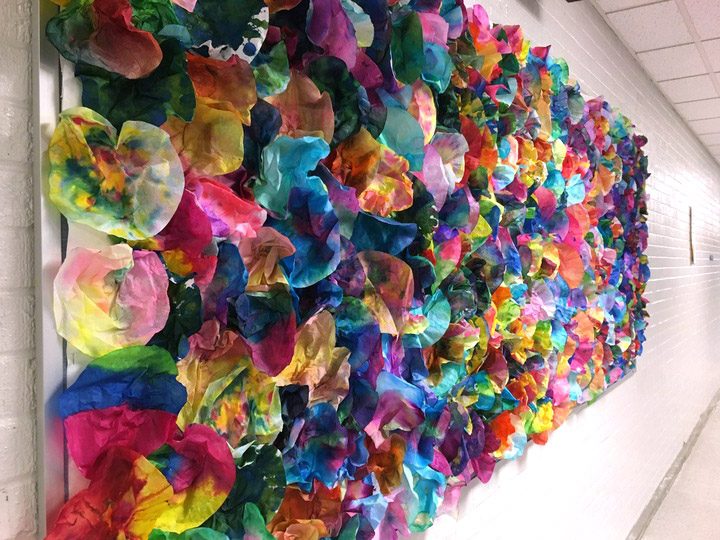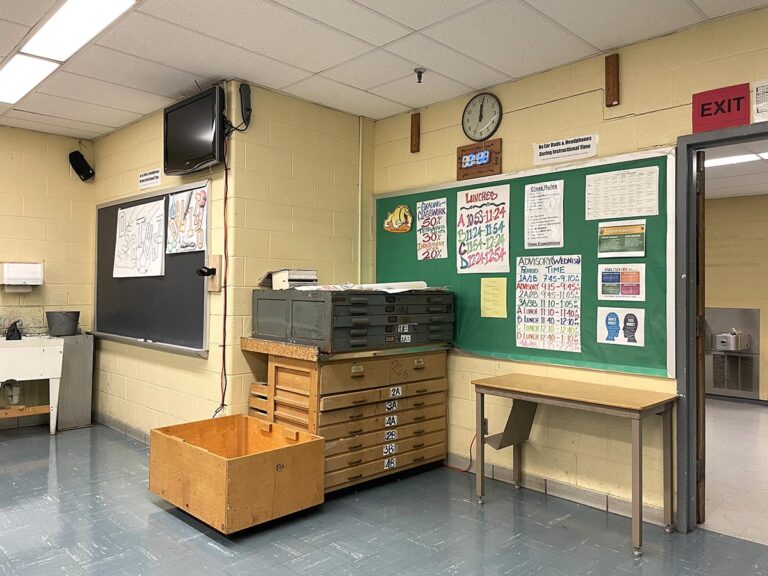Return to Learn with AOEU
As many art educators head back to school this month, one of their main concerns is creating a safe classroom environment. Several school districts have implemented new restrictions in response to the COVID-19 virus. Art educators may find themselves teaching from a cart and traveling to classrooms. If you teach in your own classroom, you may be required to make some big changes to your physical space.

Each year, you create a classroom environment to engage students and inspire creativity. While some of these new restrictions may seem limiting, you will continue to put the needs of your students first. One idea you may consider this school year is to ditch your desk. This might sound like a radical suggestion, but you may find it beneficial if you decide to take the leap.
5 Reasons to Ditch Your Desk this School Year
1. Create Space
The Center for Disease Control and Prevention, CDC, provided guiding principles for schools to keep in mind. The more people a student comes in contact with, and the longer the interaction, the higher the risk of COVID-19 spread. In response to this, many school districts are trying to maximize classrooms to safely space students apart. This may mean eliminating unnecessary furniture and classroom decorations.

If you decide to ditch your desk, you’re providing more room for your students to be spaced safely. Many teacher desks are big and bulky, and depending on how you have it positioned in your room, it can take up a lot of useful space.
Make a rough diagram of how you normally layout the physical space of your classroom. Now, sketch the same classroom without your desk, chair, and any other extra furniture. When you’re left with only student desks, you can start to space everyone out more safely.
2. Eliminate Clutter
Empty your desk to identify what you may need to keep and what you can do without. Typically an art teacher’s desk includes one drawer full of office supplies for drawing, writing, and grading. Another drawer may be full of books or files of your go-to lesson plans. A third drawer may contain personal items: a place to store your bag, toiletries, snacks, etc.

Most of these items can be eliminated or better stored without taking up floor space in your desk. Pair down your office supplies to the essential few you use in a day. These can be placed in a cup or bin that sits on your counter or in a cabinet. Chances are, you haven’t utilized many of the books or files you’ve held on to over the years. Pitch what you haven’t used recently, and find a new home for what’s left. You may consider scanning some of your handouts to make a digital copy instead. Your personal items can be moved to a locked cabinet or one out of student reach.
Once you’ve removed the contents of your desk, and have the desk hauled off or stored, your classroom may already feel lighter and less cluttered. In addition to being a safer space for students, you’ll appreciate having let go of items that were piling up and spilling out of your desk. The material objects and files are not what makes you an effective teacher. You may be surprised at how little you need.
3. Promote Engagement
Now that you’ve ditched the desk and office chair, you may be wondering, where is my space in the classroom? Well, the answer is that your space is now shared with each of your students. Without a desk, you’ve rid yourself of the temptation to sit in your corner after a demonstration. Many art teachers are used to circulating the room anyway to help with student understanding. Getting rid of your home-base desk encourages you to check in with students more.
Not only are you checking for student understanding of the course material, but also engaging with students and building positive relationships. You can find out what makes each student unique. You can learn about their summer. You can ask how they are feeling about being back at school and how they are dealing with the new conditions.
Remember that your students haven’t been in a classroom for almost six months. Many will be coming back to school, having missed interacting with their peers and teachers. Take time to talk with your students individually while they’re working. Keep safe distances, but continue to engage with students. They need that interaction in addition to your art curriculum.
4. Force Action
How often have you found yourself letting your teacher desk be a catch-all for papers, grading, and mail you mean to get to later? When the school year gets busy, our desks are often a reflection of that chaos. Student projects pile up. The agenda for your committee meeting is somewhere underneath a book you’ve been meaning to read. There may even be a paper plate or napkin from a student’s birthday treat in there somewhere.
By eliminating your teacher desk, you’re forced to make decisions and actions as items come your way. You don’t have a desk, so you’re going to need to take that stack of student projects you just collected and put them where they belong. You need to read the meeting agenda, or snap a picture of it and then recycle it. Take the book home where you might actually read it. Throw the birthday treat remnants away when you’re done with all that sugar intake.

Everything that usually tends to find a temporary home on top of your desk has a place where it belongs. Some of those items, just require you to make a decision or take action. You can grade those sketchbook assignments and return them to the cubby, rather than procrastinate. You may find yourself being more productive as a result. Ditching your desk can benefit you and your students’ physical space as well as your mental state.
5. Reduce Stress
This coming school year is bound to bring more stress than usual. We will all have a lot on our minds and more than simply our art curriculum. There’s a reason why the KonMari method of tidying up has resonated with so many people. Ditching your desk and keeping only the essential items, may make you a more effective, mindful, and forward-looking educator.
Return to Learn with AOEU
These qualities can result in reducing some stress in your role at school. Surfaces will need to be disinfected frequently to stop the spread of germs. You can rest more at ease if you have fewer surfaces to worry about, and one less place for objects and materials to pile up. Many find a cluttered space to be stressful in itself, so if you can eliminate some of that typical teacher clutter, you’re freeing up space in your classroom, but also in your mind.
Final Thoughts
A teacher’s desk has been a staple of classrooms for as long as we can remember. We fill the drawers with objects, files, and materials because we can. How many of those things do we use daily? How many of those things in our desks did we even use at all in the last school year? Most of us can admit that we can do without, or we can relocate some of those items.
Those of you who have taught art on a cart already know how to maximize learning with few materials. In a sense, you’ve always ditched the desk. What our students need now more than ever, is a safe classroom with a passionate teacher. You do not need a desk to be an effective art educator and inspire creativity. Consider ditching your desk this year and see how your classroom changes.
What is one thing in your desk that you can’t go without?
What advice would you give to a teacher who will be teaching on a cart for the first time?
How do you address the clutter in your classroom?
Magazine articles and podcasts are opinions of professional education contributors and do not necessarily represent the position of the Art of Education University (AOEU) or its academic offerings. Contributors use terms in the way they are most often talked about in the scope of their educational experiences.





